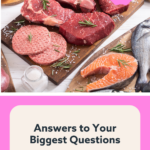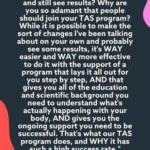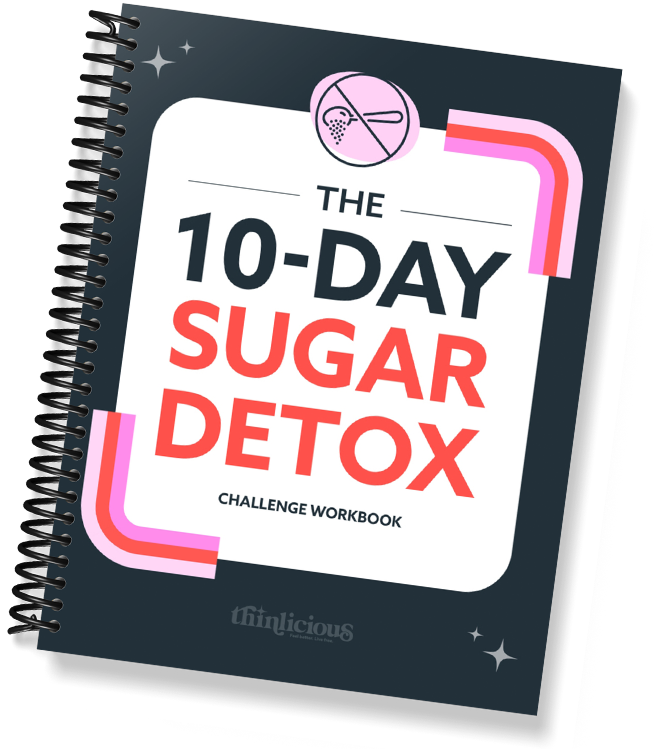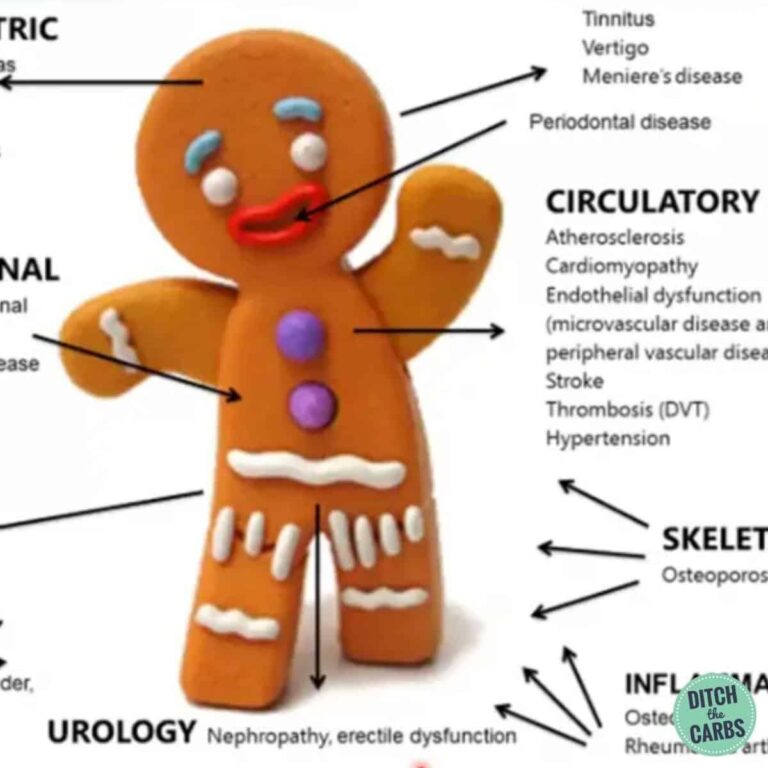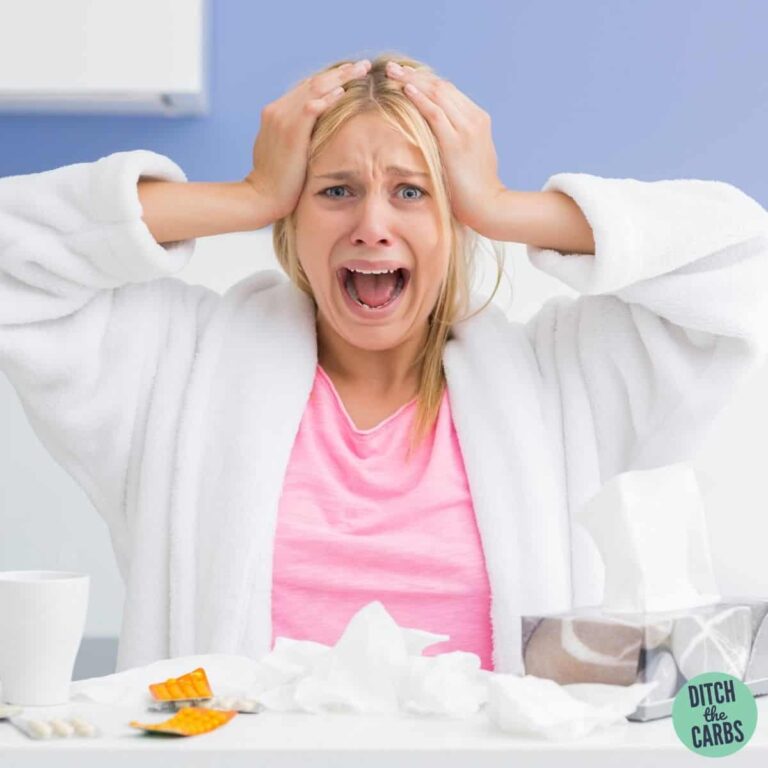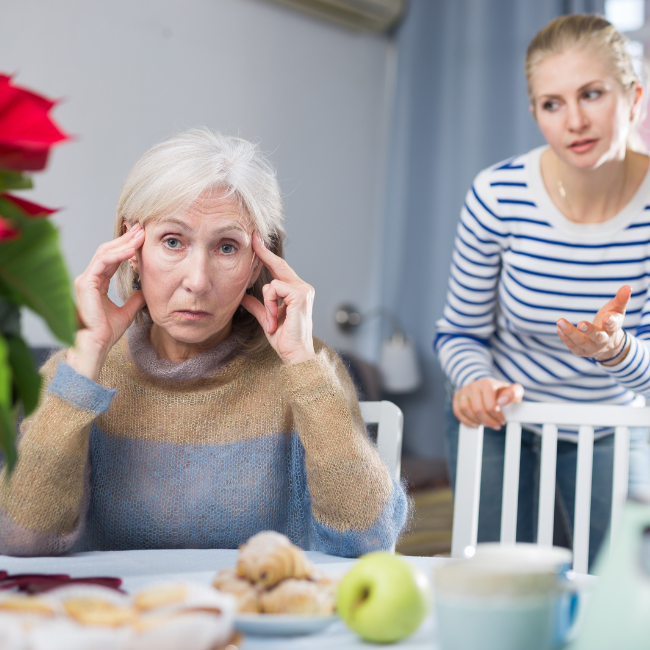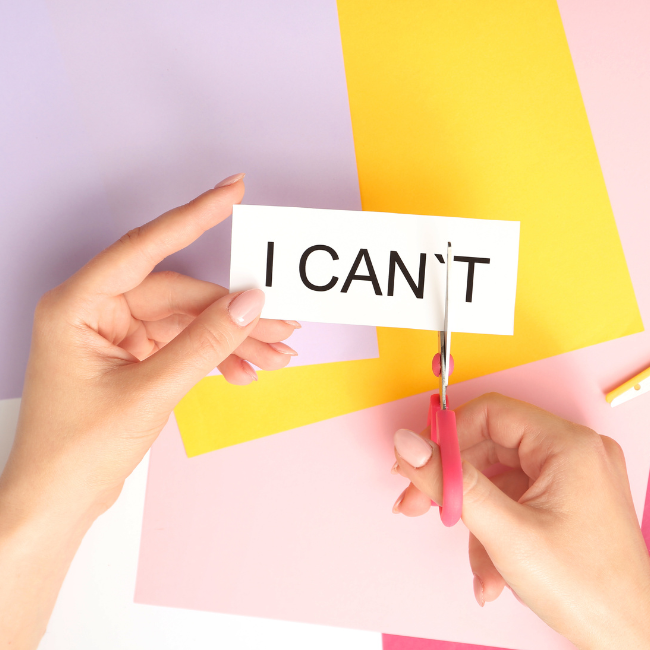Do I really have to eat this way forever?
Why is it so much easier for my husband to lose weight?
Can I drink alcohol and still see results?
What are the absolute worst things to eat that I should avoid at all costs?
Are you ready to lose weight and heal your body for life (without dieting, drugs, or making yourself miserable)?

Our free on-demand video training will walk you through how to make this THE year you set health goals…and keep them.
What if I’m a vegetarian?
Oh, the questions! Honestly, if I had a dollar for every question I’ve gotten since creating Thinlicious two and a half years ago, I could probably retire on a private island somewhere—they never stop coming!
But I get it, because I had a lot of the same questions too.
And so today, for something totally different, I thought I’d devote an entire episode to answering some of the biggest questions that I get asked over and over about losing weight and getting healthy, and about our program, just in case you’ve been wondering too.
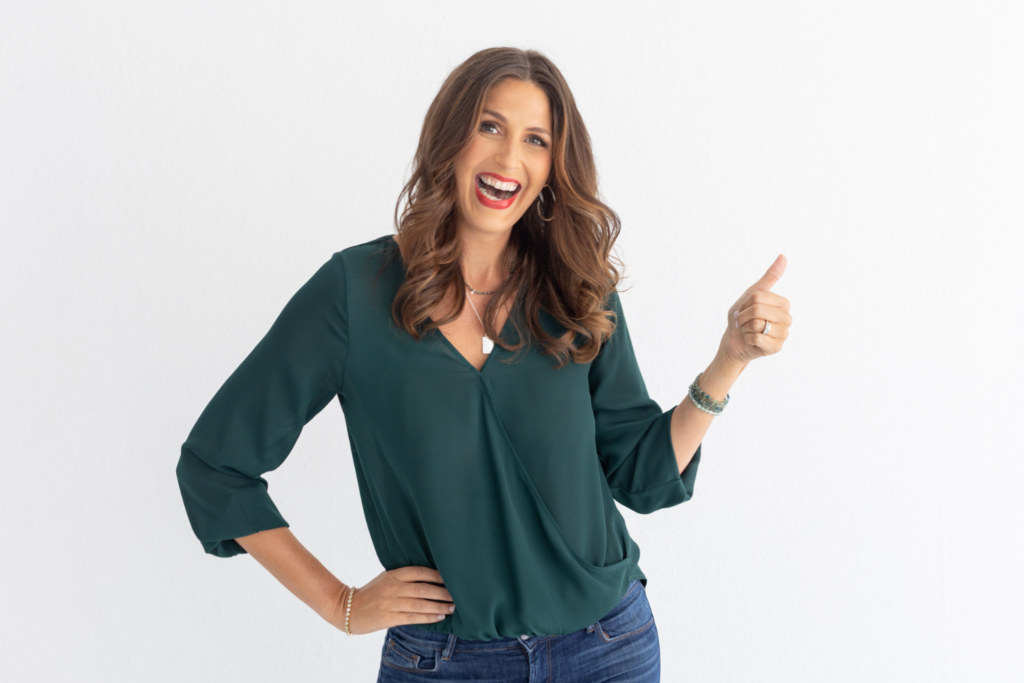
Hey there, and welcome back to the Thinlicious blog. Once again, my name is Ruth Soukup, and I am the founder of Thinlicious and the creator of the Thin Adapted System, as well as the New York Times bestselling author of seven books.
I am also a forty-something year old woman who struggled with losing weight and getting healthy for a VERY long time before I finally figured out what actually works—and that it’s NOT all the crap we’ve been told our whole lives about counting calories or eating less & exercising more.
And that’s why I created Thinlicious and started my podcast—because I want other women over 40 like me to know there is a better way to get healthy and reach your weight loss goals.
Because to me, honestly, it’s not even really about weight loss. It’s about FREEDOM.
The freedom to look and feel your absolute best. The freedom to not be controlled by food addictions ever again. The freedom to pursue all of your biggest goals and dreams because your health and your weight is no longer holding you back.
And I am so excited to dive into today’s post, because no matter how many podcast episodes I record, or how many reels I post on Instagram, there are still always more questions.
And the questions don’t annoy me—I actually LOVE them, and love answering them. Because I know for so many women, whether you’re just getting started health journey or whether you’ve been doing this for a while, it can still feel confusing or overwhelming, and you just want to have someone you can trust give it to you straight.
And that’s really why I wanted to do this blog post today—to be able to answer some of those questions that I know are probably on your mind, and to help you get a better understanding of what our program is all about, and how it can help you to lose weight and get healthy in a way that is actually sustainable for the long term.
But before we dive in, I do want to take just a second to remind you that if you are new to this blog, and to the Thinlicious program in general, and you want to learn more about how our program works, and how we can help you to lose weight and get healthy, then I have a really awesome resource that I know you’re going to absolutely love.
It’s called Flip the Switch, and it’s a super in-depth free guide that will walk you through the basics of our program, and give you a really good overview of the science behind what we do, and why it works. It’s totally free, and you can download it HERE. So again, if you’re new here, and you want to learn more about our program, then be sure to go grab that guide right here.
Okay, with that out of the way, let’s go ahead and dive into some of the most common questions I get about losing weight, getting healthy, and our TAS program.
Why does it suddenly feel like my metabolism is broken?
The first big question I want to answer is “why does it suddenly feel like my metabolism is broken when I never used to struggle with my weight?,” because this is one that comes up a lot.
And I understand why. It’s pretty frustrating when you’ve never really struggled with any sort of weight issues before, or you’ve always been able to eat whatever without a problem, and then suddenly you hit 40 or 45 or 50 or whatever age and the pounds just start creeping up, and what’s worse is that suddenly all those things you used to rely on—cutting back for a few days, or doing a juice cleanse or going on the Cabbage Soup diet for a week—just don’t really seem to have an impact anymore. The scale won’t budge. Or it keeps going up.
So here’s the simple answer: It suddenly feels like your metabolism is broken because your hormones have caught up with you.
The truth is that the Standard American Diet you’ve been eating for years, loaded with carbohydrates and processed foods and seed oils, has likely been affecting your insulin levels and probably also your gut health for a long time.
But because the rest of your hormones were still functioning properly, your body was able to adjust and handle it.
But then, when you reach a certain age and perimenopause hits, your hormones start changing. Your estrogen levels drop. Your cortisol goes up. Your thyroid levels might drop. And because all those hormones work together in a delicate balance, your insulin isn’t able to react and adjust the way it always has. Your insulin levels stay elevated.
And because insulin is what tells your body to store fat or let it go, all of the sudden your body goes into fat storage mode.
And that’s why it feels like your metabolism is broken—because it basically is.
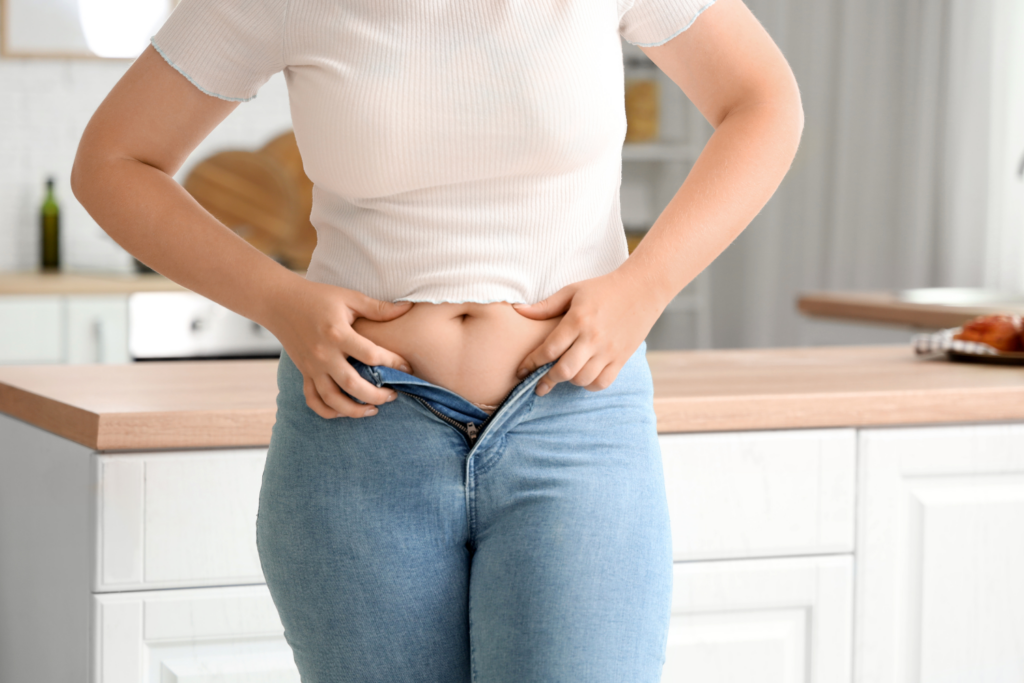
Why do you say that calories don’t matter when everyone else says you have to be in a calorie deficit to lose weight?
The next question is a big one because it basically puts people in a kerfuffle every single time I talk about it: “Why do you say that calories don’t matter when everyone else says you have to be in a calorie deficit to lose weight.”
And honestly, this is a hill I will die on, because I think it is the biggest lie we’ve been sold about losing weight and getting healthy.
Because it’s total bullshit.
And the reason calories don’t really matter, and why trying to get into a “calorie deficit” is so stupid is because YOUR BODY IS ALREADY IN A CALORIE DEFICIT.
Just keeping you alive puts you in a calorie deficit.
Every day your body has to burn thousands and thousands and thousands of calories in energy just to keep your brain functioning and your heart pumping and your organs working and blood flowing through your veins.
It’s an insane amount of energy that you are using, just to stay alive every day.
And that’s true even if you are completely sedentary and just laying in bed all day.
It’s more energy than most people could ever consume in a day.
That’s why your body has a process for creating it’s OWN energy, which happens in your mitochondria.
So calories aren’t really the problem. And “calories in, calories out” is a big farce that sounds good, but is actually meaningless.
And you’re probably thinking, but if that’s true, then why are so many people fat?
And it goes back to HORMONES.
When you’re eating foods that are keeping your insulin levels elevated all the time, your body goes into crisis mode. Because again, when your insulin is high, your body can’t burn fat.
So we’re fat because of the TYPE of food we’re eating, not the number of calories.
But I think it’s also important to understand that the type of food you’re eating also contributes to the number of calories you are able to consume. When you eat highly processed, high sugar, high carbohydrate foods, they actually make you HUNGRIER. There’s almost no limit to the amount you can consume because your body just craves more and more and more.
But when you eat the kind of foods that actually balance your hormones and nourish your body—whole, nutrient dense foods and lots of protein and healthy fat, YOU FEEL FULL.
It’s very hard to overeat those foods. It’s not physically possible for most people to eat 5,000 calories worth of meat and vegetables and healthy fat in a day. But even if you did, your body is actually designed to expel the calories it doesn’t need. That’s why you don’t see fat animals in the wild. But it only works that way if your hormones are functioning the way they should.
What should I be eating to balance my hormones?
And that brings us to the next big question—if that’s true, what should I actually be eating to balance my hormones?
And the answer to this is pretty simple.
Whole, nutrient dense foods that are as close to the way God made them as possible.
You want to be getting plenty of protein and lots of healthy fat, while limiting sugar and processed foods as much as possible.
So that means lots of MEAT, especially red meat, which is the most nutrient dense food you can eat.
It means lots of healthy fat—the kind that comes from animals, or from olives or avocados or coconuts.
It means low-glycemic fruits and vegetables—preferably locally grown and in season.
And it means cutting out all the processed crap that’s filled with toxic chemicals.
That’s the diet that is going to help you balance your hormones.
Isn’t this basically just Keto with a different name?
Which of course brings me to the next big question—isn’t this just KETO with a different name?
And it’s actually funny to me how scared people are of a ketogenic diet. Because what a lot of people don’t understand is that the concept of KETO has actually been around for long time—since a guy named William Banting wrote an essay about his experience cutting out sugar and carbohydrates in the 1860’s
And for the first half of the 20th century, the Banting method was commonly accepted in medical circles as the most effective way to lose weight, until the late 1960’s when the food industry paid big money to blame heart disease on saturated fat.
But it had a resurgence in the 1970’s with Dr. Atkin’s New Diet Revolution, before being reborn again as KETO in the early 2000’s.
But there’s a reason it keeps coming back.
The reality is that limiting sugar and processed carbohydrates while increasing protein and fat is by far the best—and pretty much the only way—to reverse insulin resistance and get your hormones functioning the way they should so that your body can release excess fat.
But here’s what else I want to say: Our program is NOT Keto.
At least, not what most people think of as Keto.
Because one of the big reasons that keto has such a bad rap is the way it is often executed.
People focus solely on getting and staying in ketosis indefinitely, which means eating an extremely high percentage of fat—where somewhere around 80-90% of their total calories are coming from fat—with a moderate amount of protein and as few carbohydrates as possible.
And they just stay there, focused on ketones and staying in ketosis.
And that doesn’t work.
Which is why our program is actually very different from keto, and also why so many people say “i tried keto, but it only worked for a while and then it didn’t work anymore.”
So how is our program different? It works in PHASES. And each phase has a different purpose.
In Phase 1, your goal is to flip the switch on your metabolism and actually get it working again. And the way you do that is by getting your body into a state of ketosis. So our phase 1 looks very similar to what most people think of when they think of keto, although we do put a much bigger emphasis on HEALTHY fat versus just any fat. But you don’t want to STAY in phase one. It’s only ever meant to be temporary—at max, 8 weeks.
Because in Phase 2, your goal is weight loss. And so in phase 2, your focus is much more on PROTEIN. You’re still eating plenty of healthy fat, but nowhere near what you were eating in phase one. And your ultimate goal during this phase is to yes, reach your weight loss goal, but also to HEAL your body and balance your hormones in order to become metabolically flexible again.
And once you’ve reached your weight loss goal, you move into Phase 3, which is where your approach becomes a lot more moderate. You can actually start adding more carbohydrates back in, because your body is now metabolically flexible and can actually handle it.
Suffice to say, this is very different from Keto, and much more effective.
Couldn’t I just do this on my own and still see results? Why are you so adamant that people should join your program?
Of course at this point you’re probably thinking, “well can’t I just do this on my own and still see results? Why are you so adamant that people should join your TAS program?
And that’s a good question. And the answer is that while it is possible to make the sort of changes I’ve been talking about on your own and probably see some results, it’s WAY easier and WAY more effective to do it with the support of a program that lays it all out for you step by step, AND that gives you all of the education and scientific background you need to understand what’s actually happening with your body, AND gives you the ongoing support you need to be successful.
That’s what our TAS program does, and WHY it has such a high success rate.
We don’t just give you a meal plan or a bunch of recipes and send you on your way.
We teach you the science BEHIND the program.
We help you fix your mindset and change your thoughts.
We give you a timeline to follow, and specific steps to add at the right time so you’re not trying to change everything all at once.
We give you a custom software designed specifically for our program to help you conveniently track your daily actions.
And we provide the most incredible support from Certified Coaches who have not only BEEN THROUGH our program, but have passed a rigorous advanced-level training and certification exam so you can feel confident they know exactly what they’re talking about.
You don’t get any of that on your own.
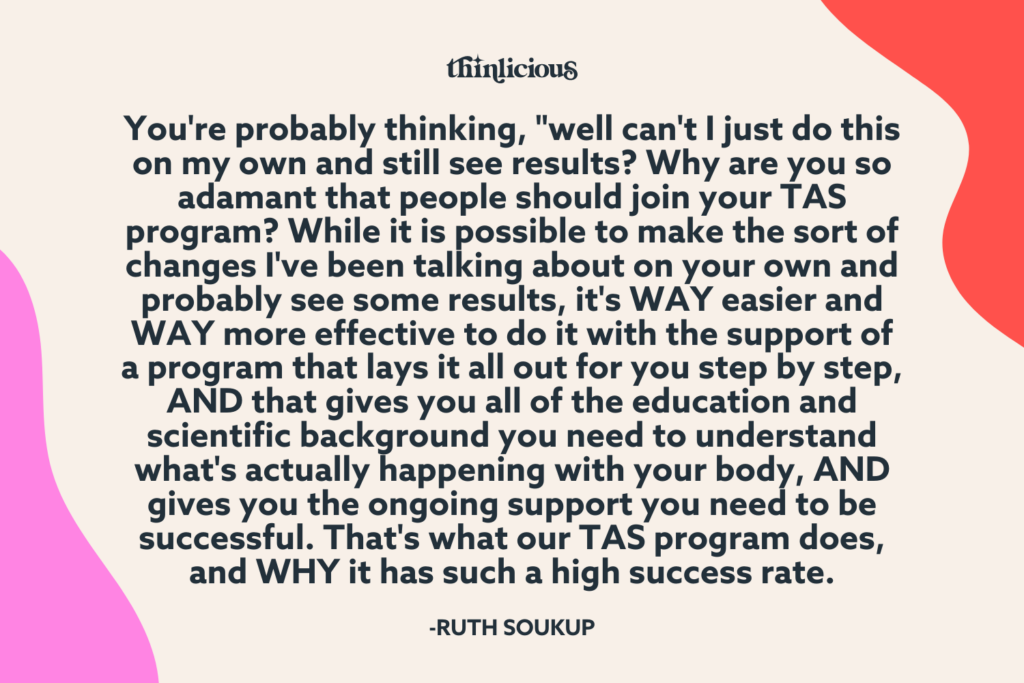
And let me say this too. I love recording my podcast, and posting tips and recipes on Instagram, and my goal is TRULY to try to help as many women as possible lose weight and get healthy in any way that I can. I work really hard to make sure ALL the content I’m putting out into the world is valuable and useful.
But I also know that the very BEST way I can help people be successful is through my program. It’s amazing. There’s nothing like it. And it will change your life.
And if losing weight and getting healthy without dieting or drugs is a serious goal for you, there’s NO better way to reach that goal than through our program.
And that’s all I’m going to say about that.
Why is it so much easier for my husband to lose weight than me?
But switching gears, another question I see a lot is “why is it so much easier for my husband to lose weight than me?”
And I feel the pain on that one, because this has always driven me crazy. My husband cuts back for 3 days and he’s down 10 pounds, and then he’s like “I’m good.” And goes back to eating whatever he wants.
Meanwhile I’m killing myself only to see the scale not budge.
So frustrating!
But the reason is the same one we already talked about—its your hormones. The sad truth is that hormonal imbalance is going to have a bigger impact on women, especially women over 40, because we have a lot more hormonal stuff going on.
But you can fix it!
Can I drink alcohol and still see results?
Okay, so what about ALCOHOL? Can you actually drink alcohol and still lose weight, or does that need to go away too?
And I’ll be honest—I love my wine. My evening glass of red wine is basically a nightly ritual for me, and not something I’m ever very eager to give up.
Plus on the weekends, my husband and I typically do a lot of entertaining and most of our social activities include a fair amount of drinking.
So I get how giving up booze is pretty hard, both from an emotional and social standpoint.
But here’s the real answer—if you’re just starting out with your weight loss journey and working to reset your metabolism, it’s best to cut out alcohol completely for at least the first 8 weeks, even if you’re drinking alcohol that is low in sugar and carbohydrates.
And the reason is that during this initial phase, your body needs to be in a state of ketosis for the process to work effectively. And alcohol can actually kick you out of ketosis and slow down your weight loss progress, because the second you drink alcohol, the only thing your body can focus on is metabolizing it.
And then after that, while you are still actively trying to lose weight, it really is best to keep alcohol to a minimum. A glass of wine here or there won’t be the worst thing in the world, but you don’t want to make it a big part of your routine.
That said, once you’ve hit your goal and have become metabolically flexible, you should be able to take a more moderate approach—just like you do for everything else..
What if I’m a vegetarian? Will this still work for me?
And while we’re diving into hot topics, we might as well hit the next one: “What if I’m a vegetarian? Can I still make this work for me?”
And you’re probably NOT going to like my answer for this one, but it’s the honest one. It’s really, really, really hard to make this work as a vegetarian. It’s so hard to get enough protein in general without eating meat, and it’s really hard to get protein as a vegetarian without also eating a lot more carbohydrates.
And this comes from someone who was a vegetarian for 28 years before I started eating meat again. And the reason I did, was because after doing the research, I realized one of my biggest problems was that I just wasn’t getting nearly enough protein.
But if you want to dive deeper into this specific topic, I have done an entire podcast episode on why I’m no longer a vegetarian, so go listen to that one and see what you think.
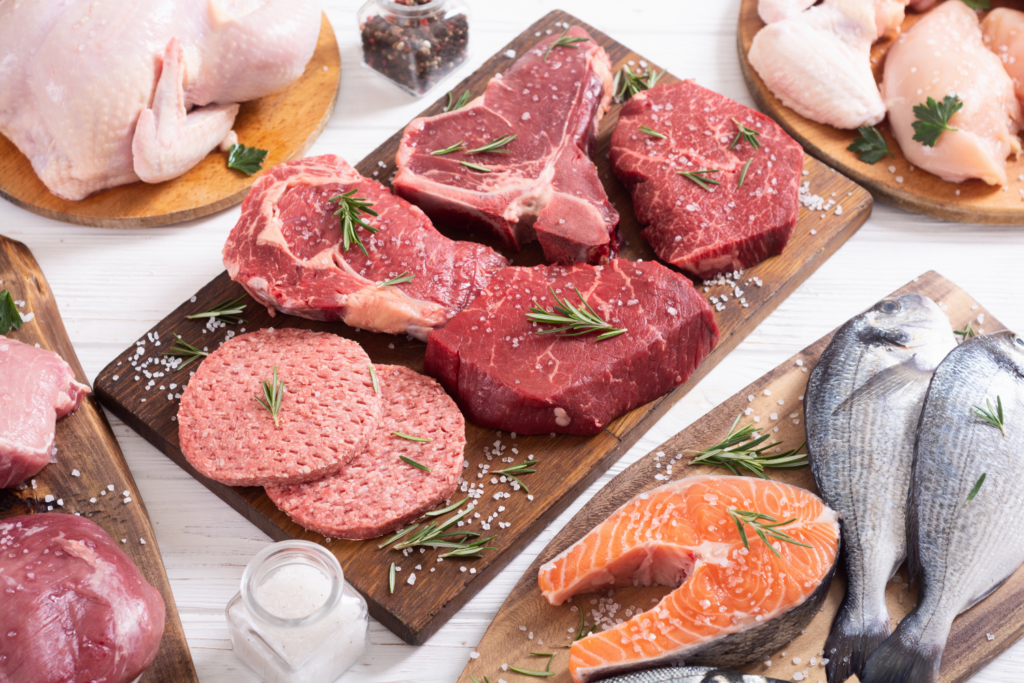
What are the absolute WORST things to eat that I should avoid at all costs?
So what are the absolute WORST foods to eat—the foods you really should avoid at all costs?
If I had to rank them, I think my top 5 WORST foods would be as follows:
- Sugar—and really the more pure, refined, chemical filled sugar it is, the worse it is. So basically candy filled with red dye and preservatives is pretty bad. Or soda or even juice, which is basically just drinking pure sugar. Just say no. There’s nothing redeeming about it.
- A close second would be highly refined, processed carbohydrates. Things like breakfast cereal or Wonder bread. Anything that’s super high in refined carbohydrates but devoid of natural fiber is basically the same as eating spoonfuls of sugar. It will instantly spike your blood sugar. And on top of that, it’s filled with preservatives and other toxic chemicals that are highly inflammatory.
- Third would be refined & processed oils—vegetable oil, canola oil, margarine, etc. Despite the claim that these are “heart healthy” fats, they’re actually TERRIBLE for you. Stick to natural, minimally processed oils and animal fats instead!
- Fourth would be deep fried foods—donuts, french fries, chips, etc. because they’re not only high in refined carbohydrates, they’re usually fried in vegetable oil, so it’s like a double whammy of terribleness for you.
- And finally, I’d avoid foods that seem healthy but actually have a lot of added sugar—things like smoothies or flavored yogurt or granola bars. THese usually have really marketing to make you feel like you’re making a good choice, but you’re not
Do I really have to eat this way FOREVER?
So I guess that brings me to the next big question….do you really have to eat this way FOREVER? Does accepting this lifestyle mean you can never again eat a donut or a plate of spaghetti or a bag of potato chips?
And here’s what I’ll say to that….when you heal your body and restore it to a state of metabolic flexibility, your metabolism will work the way it’s supposed to again, which means you can also enjoy your favorite foods, at least in moderation, without worrying that you’re going to gain all the weight back.
That’s the whole point.
But I think what you also learn is that some foods will make you feel good, and other foods will make you feel really bad. You’ll notice inflammation or fatigue, and you’ll want to eat the foods that make you feel good most of the time.
I actually did a whole podcast episode about this—titled Yes I actually Do Eat Carbs—where I talk about what my life and my typical diet looks like in phase 3. And it’s pretty moderate. I love sourdough bread and I eat potatoes and lots of fruit. And even pie every now and then.
But most of the time I choose to eat foods that are high in protein and healthy fat and low in sugar and refined carbohydrates, because that’s what makes me feel the best. Those are the foods I crave now.
I guess it kinda comes down to that Bible verse in 1 Corinthians: Everything is permissible but not everything is beneficial.
But again, if you really want to know more about what Phase 3 looks like, listen to that episode I mentioned.
What’s the best way to get started?
I could probably keep going with questions forever, but the final question I want to answer today is this: What is the best way to actually get started? Should you do a bunch of research first, or just dive in and start changing what you eat?
And I guess my answer to that is a little of both.
If you want to get started with our program, the best way to get signed up is just to go to HERE and click the button to enroll.
And once you’re inside the program, we have you start in Phase Zero, which is the PREPARE phase. We help you prep your pantry and your meals and pick a start date and also help you get mentally prepared for the changes you’ll be making.
It’s actually a really important part of the process, and I think that preparation piece is one of the reasons our clients are so successful.
Final Thoughts
Well friends, like I said, I could probably keep going through questions forever but it might get a little tedious, so we’ll call this episode PART ONE of Your Biggest Questions Answered.
But if you have more questions you’d like to see me answer, please feel free to send an email to hello@thinlicious.com.
In the meantime, if this was helpful for you, or you know someone else could benefit, please be sure to pass it along!
What if you could actually take control of
your health in just 10 days?
It’s not your fault you can’t lose weight as a woman over 40 even though you’ve likely tried literally everything. Your metabolism probably feels broken and your hormones are likely all out of whack.
But you can fix it all with ONE simple change: eliminate sugar. We make it super easy with daily lessons teaching you the science behind what makes us gain weight in our midlife and beyond! Are you ready to get started now?






